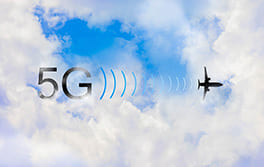
The aviation industry is no stranger to transformation. From fuel-efficient engines to biometric boarding, innovation is part of how airlines stay competitive and meet rising passenger expectations. Now, the next big shift might be arriving wirelessly: 5G.
You’ve probably heard plenty about 5G already — faster speeds, lower latency, more devices connected simultaneously. But what does that actually mean at 35,000 feet? And is the industry really ready for it?
At its core, 5G is about better connections — faster, smarter, and more resilient than anything before it. For passengers, this could finally mean an in-flight internet experience that feels more like home Wi-Fi than a laggy dial-up throwback. Think seamless streaming, smooth video calls, and real-time app access without the usual mid-flight dropouts.
But the real magic of 5G isn’t just about passenger comfort. Airlines themselves stand to benefit in major ways.
With stronger, faster connections, aircraft could transmit diagnostic and performance data in real time. That opens the door for predictive maintenance, fewer surprise delays, and better decision-making on the ground — all without waiting until the plane lands. Crew communication could become smoother. Ground operations could respond faster. Even turnaround times might shrink.
There’s also the potential for safety enhancements. Faster data transfer means more accurate, real-time information for pilots and air traffic controllers — a critical upgrade in an industry where every second counts.
No surprise — integrating 5G into commercial aviation won’t be a plug-and-play job.
For one, there’s the sheer cost. Installing new antennas, upgrading avionics, and building supporting infrastructure is a significant investment. For low-margin carriers, the business case has to be airtight.
Then there’s the regulatory complexity. Agencies like the FAA and EASA need to ensure 5G won’t interfere with critical systems like altimeters — and they’re right to move cautiously. Aviation has no room for tech that’s “mostly reliable.”
Finally, physics still matters. 5G signals — especially at higher frequencies — don’t travel far or well through metal. Ensuring stable, high-speed connections in a pressurized metal tube moving at 500 mph is no small engineering feat.
Despite the obstacles, there’s momentum. Several major carriers are already running pilot programs (pun intended), and early reports are promising. Passengers are noticing better connectivity. Airlines are seeing early gains in efficiency. Infrastructure is slowly taking shape at major hubs.
It’s likely we’ll see a hybrid future: satellites and 5G working together to keep aircraft connected gate-to-gate. Over the next five to ten years, expect the in-flight experience to feel a lot less like a digital dead zone — and a lot more like a natural extension of the always-online lives we lead on the ground.
And that’s the real shift: 5G isn’t just a tech upgrade. It’s part of a broader move toward connected aviation — one where data, devices, and decision-making are constantly in sync, whether you're on the tarmac or over the Atlantic.